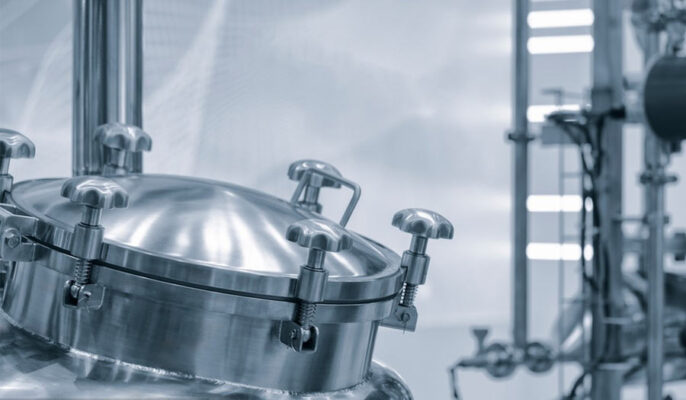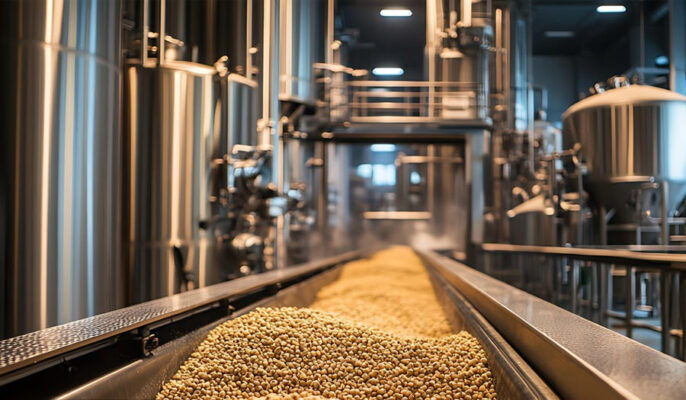Berechnung von Brauereiausrüstung Der Ausstoß ist ein wichtiger Schritt zur Gewährleistung der Produktionseffizienz und zur Optimierung des Ressourceneinsatzes während des Brauprozesses. Die Leistung einer Bierbrauanlage hängt von der Art und Größe der Brauanlage, den pro Tag gebrauten Chargen, der Größe und Anzahl der Gärtanks und dem Gärzyklus des Biers ab. Die verschiedenen Anlagen haben unterschiedliche Anforderungen in Bezug auf Standortgröße, Höhe, Wasser und Strom und sind von Ort zu Ort unterschiedlich. Beim Bierbrauen ist das Verständnis dafür, wie die Brauereianlagen den Bierausstoß berechnen, von entscheidender Bedeutung für jeden Brauer, der die Produktion optimieren und die Konsistenz aufrechterhalten möchte.
Bier ist nicht gleich Bier
Ein Punkt, den Sie bei der Berechnung der Jahresproduktion Ihrer Brauerei berücksichtigen sollten, ist die Zeit in der Dose. Wie lange bleibt das Bier in der Dose, bevor es abgefüllt werden kann? Wenn Sie Bier brauen, liegt es wahrscheinlich 4-6 Wochen in der Dose, bevor es fertig ist. Je länger das Bier in der Dose verweilt, desto weniger Bier können Sie brauen.
Überblick über die Ausrüstung zur Bierherstellung
Maischebottich
Ein Maischebottich ist ein Gerät, das Malz mit Wasser vermischt und erhitzt, um den Zucker zu extrahieren. Die Effizienz des Maischprozesses wirkt sich direkt auf den Zuckergehalt und das Volumen der fertigen Würze aus.
Berechnungsmethode: Die Maischeeffizienz kann durch Messung des Volumens und des Zuckergehalts der Würze vor und nach der Maische berechnet werden. Dabei werden in der Regel die Differenz des spezifischen Gewichts und die Volumenänderung der Würze vor und nach der Maische berücksichtigt.
Siedekessel
Im Kochkessel wird die Würze gekocht und Hopfen zugegeben. Während dieses Vorgangs nimmt die Würze durch Verdunstung ab, was sich auf den endgültigen Ertrag auswirkt.
Berechnungsmethode: Der Kochverlust kann durch Beobachtung der Kochzeit, der Temperatur und der Veränderung des Würzevolumens in der Pfanne geschätzt werden. Die Verdampfungsrate wird in der Regel zur Berechnung des Endvolumens der Würze verwendet.
Gärbehälter
Der Gärtank wird für die Hauptgärung und die Nachgärung verwendet. Das Biervolumen ändert sich während des Gärprozesses durch die Bildung von Gas und Sedimenten.
Berechnungsmethode: Die endgültige Bierausbeute kann durch Messung des Volumens zu Beginn und am Ende der Gärung in Verbindung mit der Aufzeichnung der Gärverluste berechnet werden. Das Volumenüberwachungssystem des Gärtanks liefert in der Regel Echtzeitdaten.

Filter
Filter werden verwendet, um nach der Gärung Feststoffe aus dem Bier zu entfernen, um die Klarheit und Stabilität des Bieres zu gewährleisten.
Berechnungsmethode: Während des Filtrationsprozesses nimmt das Volumen des Biers aufgrund der Entfernung von Feststoffen ab. Die Aufzeichnung der Volumenänderung vor und nach der Filtration kann bei der Berechnung des Filtrationsverlustes helfen.
Verpackungsmaterial
Die Verpackungsanlagen füllen das Bier in Flaschen, Dosen oder Fässer ab und verschließen sie. Während des Verpackungsvorgangs kommt es auch zu gewissen Verlusten.
Berechnungsmethode: Durch Aufzeichnung des Volumens vor der Verpackung und des tatsächlichen Füllvolumens kann der Verpackungsverlust berechnet werden. In der Regel liefert das Dosiersystem der Verpackungsanlage genaue Daten.
Schlüsselfaktoren für die Berechnung der Bierausbeute
- Würzeausbeute: Der erste Schritt zur Berechnung der Bierausbeute besteht darin, die während des Brauprozesses produzierte Würzemenge zu messen. Dies geschieht in der Regel mit einem in die Brauanlage integrierten Volumensensor oder Durchflussmesser.
- Spezifische Schwerkraft: Die spezifische Schwerkraft misst die Dichte der Würze im Verhältnis zu Wasser und hilft bei der Abschätzung der Menge an vergärbarem Zucker. Brauer verwenden Geräte wie Aräometer oder Refraktometer, um die spezifische Dichte vor und nach der Gärung zu messen.
- Alkoholgehalt: Der Alkoholgehalt von Bier wird auf der Grundlage des Unterschieds zwischen dem spezifischen Gewicht vor und nach der Gärung berechnet. Diese Differenz gibt an, wie viel Zucker während des Brauprozesses in Alkohol umgewandelt wird.
- Braueffizienz: Die Effizienz des Brauprozesses beeinflusst die Extraktion und Verwertung des Zuckers.
- Hefestämme und Gärungsbedingungen: Unterschiedliche Hefestämme und Gärtemperaturen können die Entwicklung des Geschmacks und die Eigenschaften des fertigen Biers beeinflussen.
Berechnung der Brauereiproduktion
Der Einfachheit halber rechnen wir mit 20 Produktionszyklen für Gärung und Konditionierung pro Jahr. Gärung und Reifung/Lagerung in CCT-Einheitstanks.
Wir berechnen: Ein durchschnittlicher Zyklus Gärung + Lagerung dauert 17-18 Tage, 350 Tage pro Jahr geteilt durch 17 Tage = 20 Produktionszyklen pro Jahr.

Berechnung der Brauereikapazität - Kellertanks
Es gibt verschiedene Arten von Tanks, die Sie für Ihren Brauprozess verwenden können:
- Gärbehälter
- Klare Biertanks
- Horizontale Reifetanks
- Serviertanks
Die von Ihnen gewählten Biertanks wirken sich auf den Ausstoß und die Arbeitskosten Ihrer Brauerei aus. Wenn Sie zum Beispiel eine Gasthausbrauerei betreiben, sind Biertanks eine gute Option. Einige Brauereien lagern Biertanks in einem Kühler und schenken das Bier direkt aus diesen Tanks an der Bar aus. Das spart Arbeitskräfte, so dass das Fassbier nicht für das Fassbier verwendet wird.
Die Anzahl der Behälter in der Brauerei
Die Bauweise der Brauerei wirkt sich auch auf die Menge des Biers aus, das vor Ort gebraut werden kann. Die in Hotels, Bars, Brauereien und Restaurants verwendeten Heimbrauanlagen und Anlagen zum Brauen von Craft Beer verwenden in der Regel 500L oder 1000L 2-Behälter, 2-Tank-3-Behälter, 2-Behälter + Heißwasserkessel. Pro Tag werden 1-2 Chargen verzuckert. Unter Berücksichtigung von Faktoren wie Arbeitsaufwand und Arbeitsintensität wird eine Charge pro Tag verwendet.
Die häufigste Variante:
- 3-Behälter-System: kombinierter Maische-/Filtrationstank und Kessel/Wirbeltank
- 3-Gefäß-System: kombinierter Maische-/Filtrationstank mit separatem Kessel und Vortex-Tank oder separater Maische- und Filtrationstank mit kombiniertem Kessel/Vortex-Tank
- 4-Gefäß-System: separate Maische, Filtration, Kessel und Wirbeltank
Je mehr Gefäße eine Brauerei hat, desto mehr Bier kann an einem Tag gebraut werden. Mit einer 2-Kessel-Anlage kann man vielleicht 2 Mal brauen, aber das wird ein langer Tag. Einige Brauereien verfügen über 5- oder 6-Fass-Systeme und können mehr als 6 Mal am Tag brauen. Während des Brauprozesses ist es nicht die Anzahl der Kellertanks, die den Ausstoß einer Brauerei begrenzt, sondern das Design der Brauerei.

Verfahren zur Berechnung des Brauereiausstoßes
Datenerhebung
- Rohstoffdaten: Erfassen Sie die Einsatzmenge jedes Rohstoffs, einschließlich Malz, Hopfen und Wasser.
- Prozessdaten: Aufzeichnung der Mengen- und Qualitätsdaten während der Maische, des Kochens, der Gärung, der Filtration und der Verpackung. Moderne Anlagen sind in der Regel mit Sensoren und automatischen Aufzeichnungssystemen ausgestattet, um diese Daten in Echtzeit zu erfassen.
Berechnung der Daten
Berechnung der Maischeeffizienz: Berechnung der Maischeeffizienz auf der Grundlage des Volumens und des Zuckergehalts der Würze vor und nach der Maische.
- Die Formel lautet: Maischeeffizienz = die Menge des extrahierten löslichen Zuckers ÷ die Menge des in das Malz eingebrachten Zuckers
- Berechnung des Siedeverlustes: Schätzen Sie den Siedeverlust, indem Sie die Volumendifferenz der Würze vor und nach dem Kochen messen und die Verdampfungsrate kombinieren.
- Berechnung des Gärungsverlusts: Aufzeichnung der Volumenänderung des Biers vor und nach der Gärung und Berechnung des Gärungsverlusts durch Kombination der während des Gärungsprozesses entstandenen Gase und Sedimente.
- Berechnung des Filtrationsverlustes: Berechnen Sie den Filtrationsverlust auf der Grundlage der Volumendifferenz vor und nach der Filtration.
- Berechnung des Verpackungsverlustes: Berechnung des Verpackungsverlustes durch Messung des Volumens vor der Verpackung und des tatsächlichen Füllvolumens.
Analyse der Daten
- Ertragsprognose: Vorhersage der künftigen Produktionsleistung durch Kombination historischer Produktionsdaten und aktueller Produktionsbedingungen.
- Qualitätskontrolle: Analysieren Sie die Produktionsdaten, um die Effizienz jeder einzelnen Verbindung zu gewährleisten und die Produktkonsistenz zu erhalten.
- Kostenkontrolle: Optimieren Sie den Produktionsprozess und das Kostenmanagement auf der Grundlage der Verlustdaten der einzelnen Verbindungen.
Schlussfolgerung
Das Verständnis dafür, wie Brauereianlagen den Bierausstoß berechnen, ist für Brauereien von entscheidender Bedeutung, um die Effizienz zu steigern und Qualitätsstandards einzuhalten. Durch die Beherrschung dieser Berechnungen und den Einsatz fortschrittlicher Brautechniken können Brauereien konsistente Ergebnisse erzielen und die Bedürfnisse von Bierliebhabern auf der ganzen Welt befriedigen. Für diejenigen, die eine Brauerei bauen oder aufrüsten möchten, bietet die Micet-Gruppe ein umfassendes Angebot an Brauereianlagen und Hilfssystemen, die den unterschiedlichen Brauereibedürfnissen gerecht werden. Von Malzschrotmühlen bis hin zu Abfüllanlagen und Fässern bietet Micet Group die für den Brauerfolg erforderlichen Werkzeuge.




